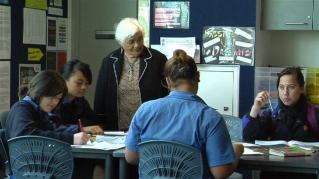Section navigation
Using data to make changes to teaching and learning
Refer to the video: Collecting and using school data
In this presentation, Ministry of Education officer Chris Day discusses how school leaders can lead a process of collecting, analysing, and using data for teaching and learning as well as for management and organisational purposes. He illustrates his presentation by referring to his previous work as principal of Whakatane High School.
Think about the following questions:
- What data should schools collect?
[Note comments about the need to collect formative and summative data, quantitative and qualitative (e.g,. satisfaction surveys) data, the need to collect data because it will be useful, and the need to ensure that the data-collecting process is manageable: “Make a strategic decision about the data you’ve already got – how can you better manage it?”]
- How should schools use the data they collect?
[Data can be used for “class placement, next steps in the learning process, setting your planning and reporting targets and so on, departmental targets.” “But more importantly, in my view, is – how can you change the data into information that’ll tell you ‘are we making a difference in our school?”
Note how Day has used his data to prioritise targets in the school charter: “Goal one was that the board was concerned about raising Māori achievement … and the tool we were using was Te Kotahitanga.”]
-
What does an effective school leader need to know and do in order to lead the data analysis process usefully?[The leader needs to:
have a vision of what to do with data and how to use it; - be data-literate in terms of understanding how data can be analysed and used (note Day’s understanding of the need to disaggregate data in order to demonstrate Māori student achievement, and his comments about the strategic use of school management systems);
- be prepared to lead ‘difficult’ data-based conversations with teachers: “OK, get the five teachers’ worth of data, disaggregate it see which teachers were continually ‘failing’, if you like, certain kids, certain groups of kids. And that was a very powerful tool, not in a negative way, but to say ‘look, this is the information, how can we work together to try and improve this?’ ”;
- show himself or herself to be a learner as well. Note the occasions, in the presentation, when Day admits to a lack of knowledge or understanding and describes how he gained understanding.]
- What points does Day make about how to use data effectively in order to convince teachers about the need to undertake professional learning that focuses on strengthening Māori students’ engagement and achievement?
[Note the process that Day used with his own staff – he shared and analysed a range of international, national, and local data that helped them to gain an understanding of Māori student achievement levels and how they compared with with non-Māori student achievement levels. Note, in particular, the use he makes of data around Māori student retention and attendance rates to address the question: ‘Why focus on our Māori students?’ He says: “ ‘We treat all kids the same’ came the comment. OK! By treating all kids the same, we still have that huge disparity!”
Note also Day’s comment on the relationship between student achievement data and decile rating: “When I was in a school, I never referred to the decile because I felt it was a bit of a cop-out … I’d much rather compare our students to the whole country.”]


